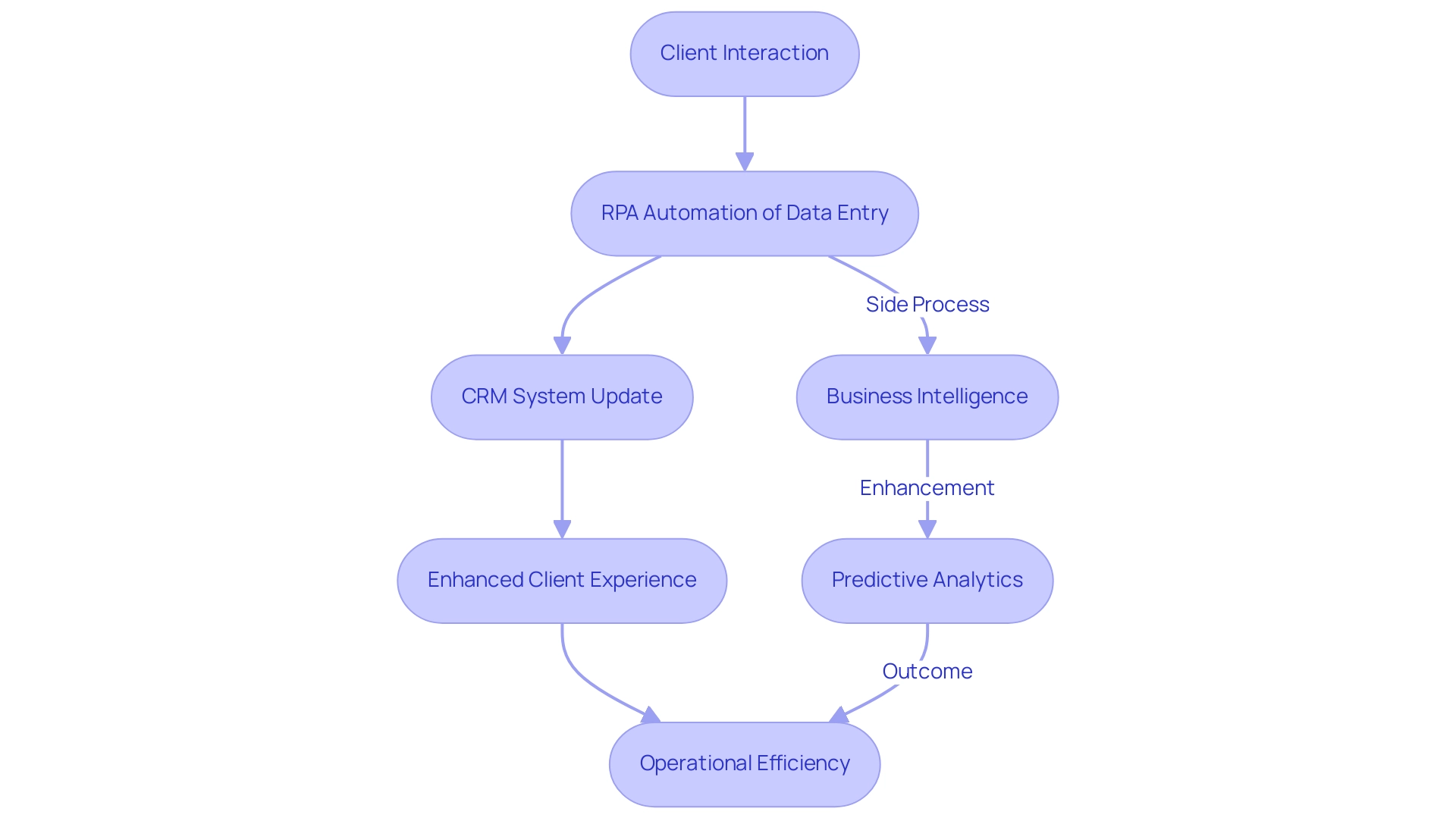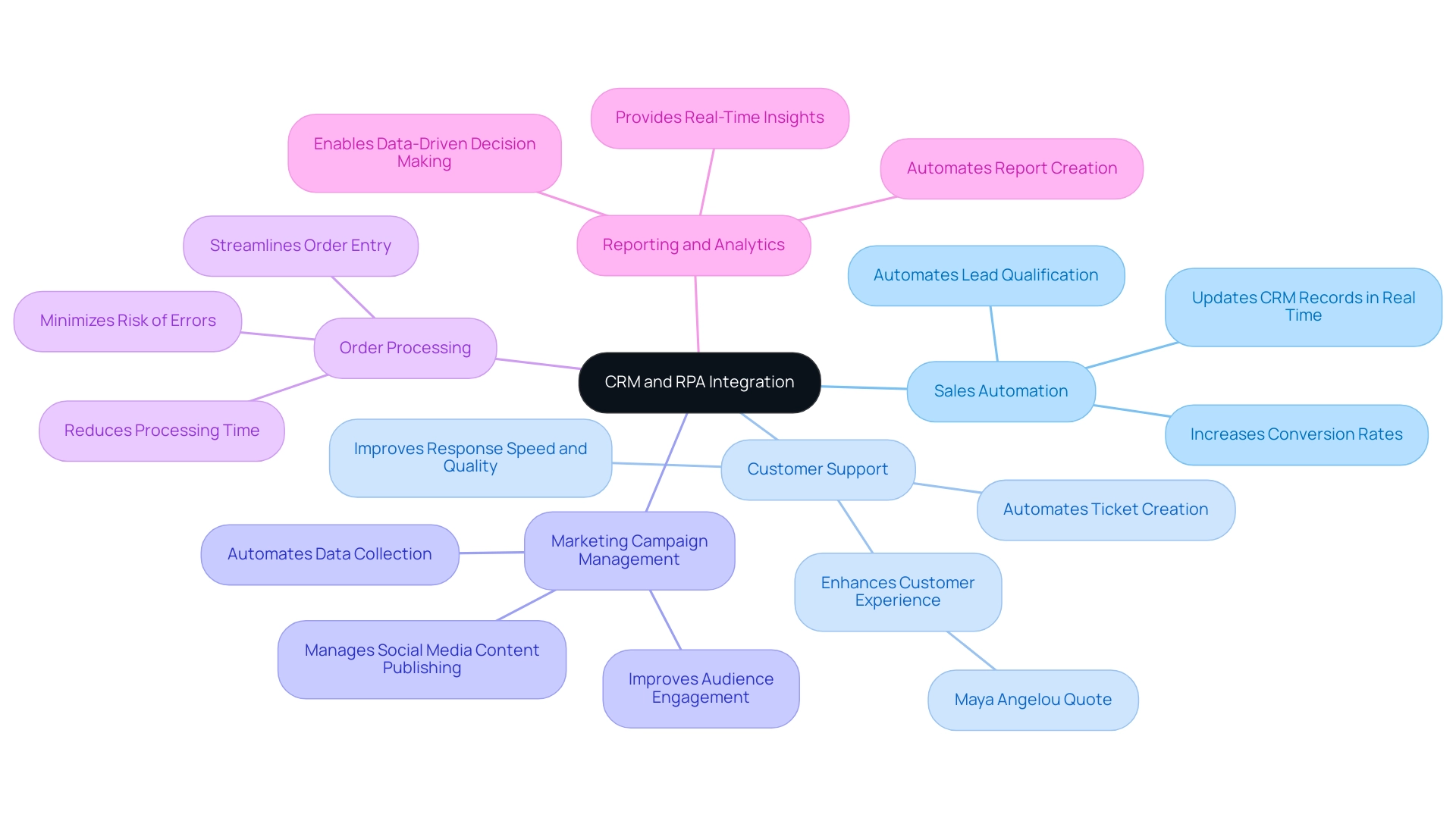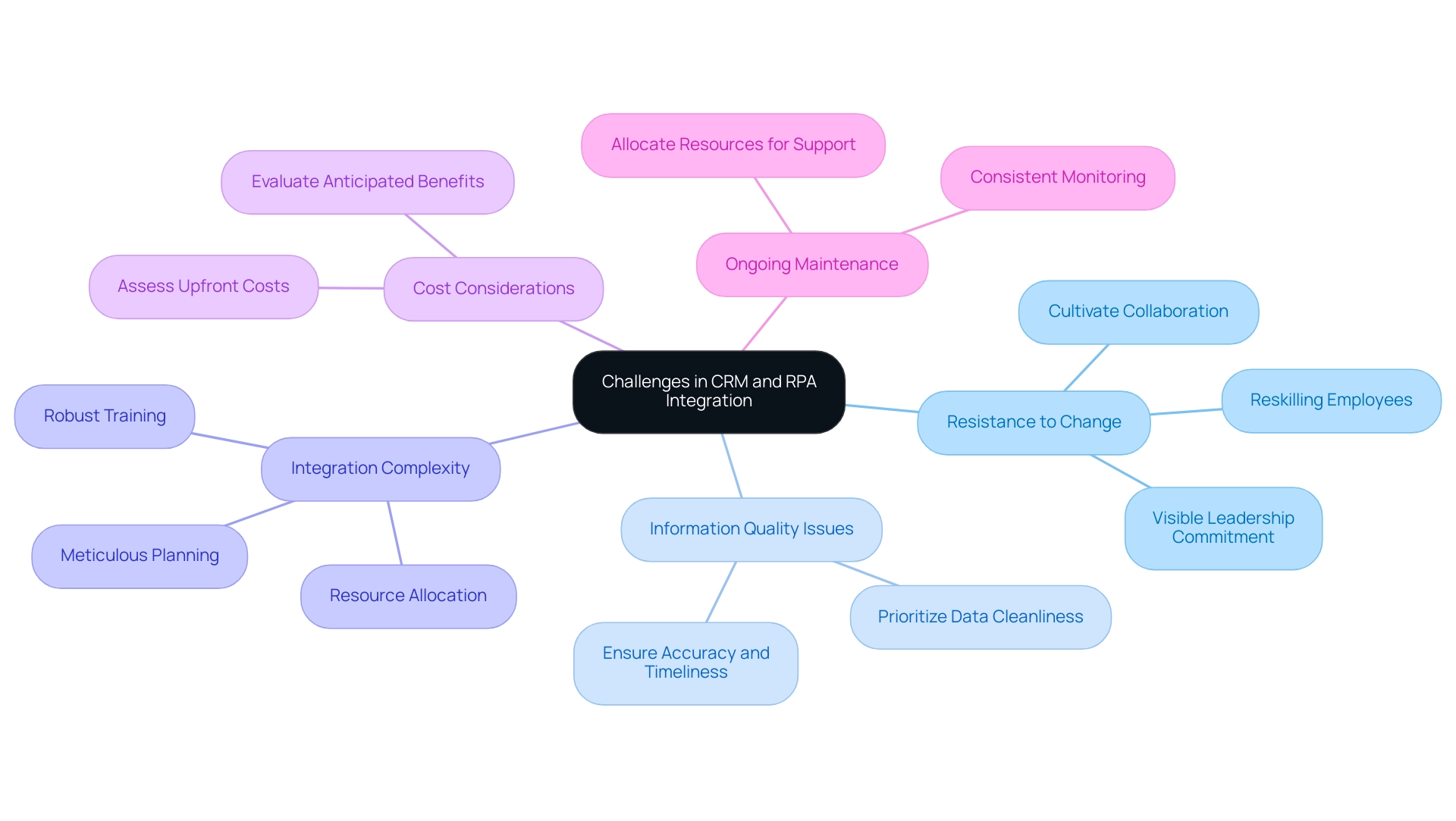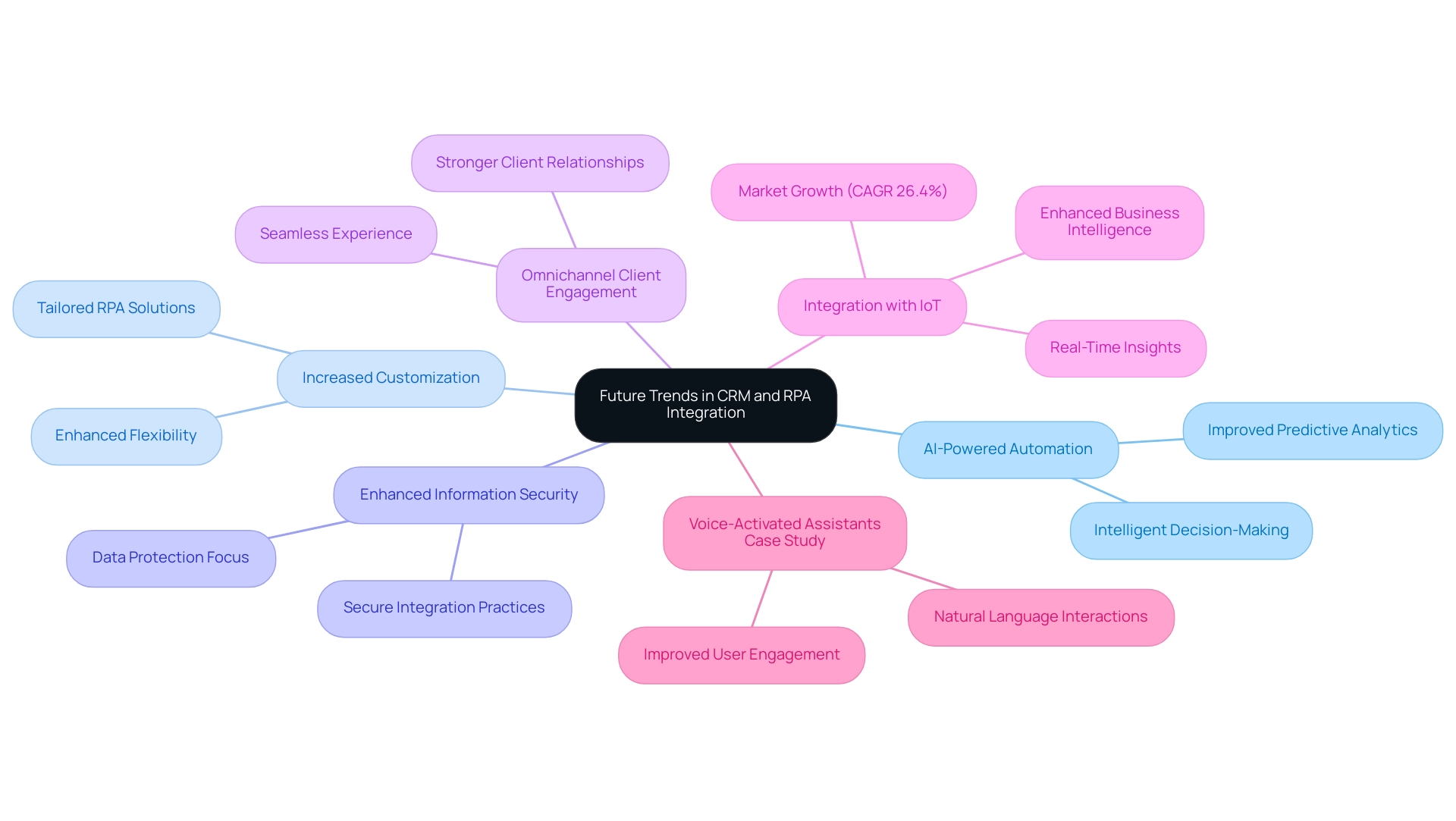Introduction
In the dynamic landscape of modern business, the integration of Customer Relationship Management (CRM) systems and Robotic Process Automation (RPA) is revolutionizing how organizations operate. By harnessing the power of these technologies, businesses can streamline their processes, enhance customer interactions, and drive efficiency to new heights. As companies grapple with the demands of a fast-paced environment, understanding the synergy between CRM and RPA becomes crucial for unlocking operational success.
This article delves into the transformative benefits of this integration, showcasing practical applications across various industries while addressing the challenges organizations face in implementation. With insights into future trends and real-world case studies, readers will discover actionable strategies for leveraging these technologies to propel their businesses forward.
Understanding CRM and RPA: A Comprehensive Overview
Client Relationship Management (CRM) systems act as the backbone for managing interactions with both current and prospective clients. By organizing client information and tracking interactions, these systems enable businesses to streamline processes, enhance service, and ultimately boost profitability. Recent advancements in CRM technology, such as AI-driven analytics and improved user interfaces, have further empowered organizations to customize their interactions with clients more effectively. Conversely, Robotic Process Automation (RPA) employs software robots to automate repetitive tasks traditionally performed by humans, such as information entry and transaction processing. Our innovative RPA solutions, including EMMA RPA and Microsoft Power Automate, are designed to not only enhance operational efficiency but also improve employee morale through user-friendly digitalization.
The synergy between CRM and RPA is transformative. By incorporating these technologies, organizations can automate workflows that involve client information, ensuring seamless information flow between systems. For example, when a client submits an online form, RPA can promptly input that information into the CRM, significantly reducing manual entry mistakes and freeing staff to concentrate on higher-value strategic initiatives. This integration not only improves operational efficiency but also enriches the overall client experience by ensuring that information is accurate and accessible when required.
In 2024, the latest advancements emphasize that the merging of CRM and RPA is becoming progressively sophisticated, with new tools emerging that provide predictive analytics and real-time information processing capabilities. Furthermore, the significance of Business Intelligence in this context cannot be overstated; it propels the extraction of actionable insights from the information handled by CRM systems. Case studies, including those from prominent call centers, illustrate how the combination of CRM and RPA, backed by Business Intelligence, has maximized efficiency and service quality, resulting in enhanced satisfaction rates. These advancements illustrate a clear path toward optimizing workforce performance and achieving operational success, empowering organizations to leverage tailored AI solutions for informed decision-making and sustained growth. Moreover, it is essential to recognize the challenges companies encounter in adopting these technologies, such as integration complexities and quality issues, which can obstruct their capacity to fully achieve the advantages of RPA and AI.

Key Benefits of CRM and RPA Integration for Businesses
The integration of Customer Relationship Management (CRM) systems with Robotic Process Automation (RPA) presents a multitude of advantages for businesses aiming to enhance their operational efficiency:
- Enhanced Productivity: By automating routine tasks such as information input and lead management, employees can redirect their efforts toward high-impact activities like client engagement and strategic planning. A recent case study involving a mid-sized healthcare company demonstrated a remarkable 30% reduction in processing time for client inquiries after implementing RPA alongside their CRM system, showcasing how GUI automation can revolutionize operational workflows.
- Enhanced Precision: RPA greatly minimizes human mistakes in information management by ensuring that client details are consistently and precisely entered into CRM systems. This level of precision is crucial, especially as 40% of employees in Singapore express dissatisfaction with their work experience, underscoring the need for reliable systems. Businesses that utilized RPA in their CRM processes reported a 25% decrease in entry errors, enhancing overall accuracy.
- Enhanced Client Experience: Rapid processing times and accurate data management enable businesses to respond to inquiries swiftly, leading to higher satisfaction rates. For instance, after integrating RPA with CRM systems, one company reported a 20% increase in satisfaction scores, illustrating how automation can transform the journey into a more responsive and personalized experience.
- Scalability: As organizations expand, RPA provides a flexible solution to manage increased workloads without necessitating a linear increase in staff. This cost-effective method enables businesses to uphold quality relationships with clients while scaling operations. For instance, another client was able to double its client base without increasing its operational costs, thanks to RPA.
- Improved Information Insights: Integrated systems enable businesses to leverage analytics effectively, gaining understanding of consumer behaviors and preferences. This informed decision-making is essential for tailoring services and enhancing overall client satisfaction. A study discovered that companies that combined RPA with their CRM systems reported a 15% enhancement in information-driven decision-making capabilities.
Before deploying RPA, the mid-sized healthcare firm encountered challenges such as manual information entry errors and slow response times, which obstructed operational efficiency. In light of these benefits, industry leaders recognize the critical role of automation in shaping future business practices. As Jeff Bezos eloquently stated,
I predict that, because of artificial intelligence and its ability to automate certain tasks that in the past were impossible to automate, not only will we have a much wealthier civilization, but the quality of work will go up very significantly.
This vision encapsulates the transformative impact of RPA and CRM integration, making it an essential strategy for businesses looking to thrive in 2024 and beyond. Notably, the ROI from these implementations was achieved within six months, further underscoring the effectiveness of the solution.

Common Use Cases for CRM and RPA Integration
Numerous industries are harnessing the power of CRM and RPA integration to elevate their operational efficiency and effectiveness. Starting at just $500 per month, RPA solutions are a cost-effective option for businesses aiming to streamline their processes. Here are several impactful use cases that highlight how RPA addresses workplace challenges and enhances productivity:
-
Sales Automation: RPA empowers sales teams to automate lead qualification processes by analyzing incoming leads and updating CRM records in real time. This ensures that sales representatives can focus on high-potential opportunities, ultimately increasing conversion rates.
-
Customer Support: By implementing RPA, organizations can automate ticket creation and follow-up tasks in CRM systems. As Maya Angelou famously said, “I’ve learned that people will forget what you said, people will forget what you did, but people will never forget how you made them feel.” This automation improves the speed and quality of support, allowing teams to respond to inquiries with greater efficiency and precision.
-
Marketing Campaign Management: RPA enables the automation of information gathering from different sources, allowing marketers to design targeted campaigns based on thorough client insights stored in their CRMs. A pertinent case study on marketing automation illustrates how RPA can significantly enhance marketing efforts by automating information collection for market analysis and managing social media content publishing, resulting in more effective strategies and improved audience engagement.
-
Order Processing: RPA streamlines the order entry process by automatically updating CRM systems with order details. This not only reduces processing time but also minimizes the risk of errors, ensuring smoother order fulfillment.
-
Reporting and Analytics: Integrating RPA with CRM systems allows businesses to automate the creation of reports and dashboards. This integration offers stakeholders with real-time insights into sales performance and client engagement metrics, enabling informed, data-driven decision-making.
In addition to these applications, RPA can help alleviate staffing shortages by automating routine tasks that would otherwise require additional personnel, allowing organizations to allocate their human resources more effectively. Furthermore, addressing the repetitive nature of certain tasks can significantly improve employee morale, as team members can focus on more engaging and strategic work.
As organizations adopt these technologies, it is crucial to address information security and compliance concerns, particularly since RPA solutions frequently manage sensitive information. Ensuring compliance with global information processing standards and implementing robust security measures will safeguard both the organization and its customers.

Challenges in Implementing CRM and RPA Integration
Integrating CRM and RPA technologies offers significant advantages, yet organizations often encounter a range of challenges:
-
Resistance to Change: A common hurdle is the reluctance among employees to embrace new technologies. Studies indicate that over 60% of employees fear job displacement due to automation. To mitigate this resistance, it’s crucial for organizations to cultivate a culture of collaboration and continuous learning, supported by visible leadership commitment. As Kamin C. insightfully states,
By showing them how automation can take over mundane, repetitive tasks, they’ll see how it frees up their time for more engaging and creative work.
Additionally, organizations can alleviate fears by hiring from within and reskilling employees, creating new job opportunities and demonstrating a commitment to workforce development. -
Information Quality Issues: The effectiveness of RPA is heavily reliant on the quality of information within CRM systems. Organizations must prioritize the cleanliness, accuracy, and timeliness of their information before deploying RPA solutions to ensure that they can unlock the full potential of Business Intelligence in driving informed decision-making.
-
Integration Complexity: The task of integrating RPA with existing CRM systems can be intricate, necessitating meticulous planning and execution. Investing in robust training and resource allocation is essential to ensure a smooth integration process, which is vital for leveraging tailored AI solutions that align with specific business goals.
-
Cost Considerations: While RPA can yield substantial long-term savings, the upfront costs associated with technology acquisition and employee training can be considerable. Organizations need to carefully assess these costs against anticipated benefits to justify their investment, particularly in an evolving AI landscape.
-
Ongoing Maintenance: Post-implementation, RPA systems demand consistent monitoring and maintenance to maintain optimal performance. Companies should be prepared to allocate adequate resources for ongoing support, ensuring the sustainability of their RPA initiatives. Furthermore, it’s important to recognize that while many employees perceive intelligent automation as a threat to their jobs, RPA and AI are designed to free them from repetitive tasks, potentially creating new job opportunities and enhancing overall business productivity. RPA not only streamlines workflows and reduces errors but also works in tandem with Business Intelligence to provide actionable insights, empowering organizations to make informed decisions that drive growth and innovation.

Future Trends in CRM and RPA Integration
As technology continues to evolve, several pivotal trends are emerging in the integration of CRM and RPA technologies:
-
AI-Powered Automation: The synergy of artificial intelligence with robotic process automation (RPA) is set to transform how organizations operate. This integration will facilitate intelligent decision-making and improve predictive analytics within CRM systems, allowing businesses to customize their services to meet client needs more effectively. By leveraging tailored AI solutions, companies can navigate the complexities of the evolving AI landscape, ensuring alignment with their specific business goals.
-
Increased Customization: Organizations are increasingly seeking RPA solutions that can be tailored to their specific CRM workflows. This trend towards customization fosters greater flexibility and adaptability in automation processes, enabling businesses to respond swiftly to changing demands and enhance operational efficiency.
-
Enhanced Information Security: With rising concerns over privacy, organizations are prioritizing secure integration practices. This focus on data protection ensures that client information remains safeguarded while leveraging the efficiencies offered by RPA technologies, ultimately supporting informed decision-making.
-
Omnichannel Client Engagement: RPA will become instrumental in managing interactions across a multitude of channels. By ensuring a seamless experience, businesses can foster stronger relationships with their clients, regardless of how they choose to engage, driving overall productivity.
-
Integration with IoT: The convergence of Internet of Things (IoT) technologies with CRM systems is poised to revolutionize data collection and analysis. The IoT market, valued at $384.70 billion in 2021, is projected to grow to $2,465.26 billion by 2029, demonstrating a CAGR of 26.4%. This integration will enable real-time insights, allowing businesses to proactively address client needs and preferences, enhancing business intelligence capabilities.
-
Case Study – Voice-Activated Assistants: As highlighted in the case study titled ‘Transforming User Experience: The Rise of Voice and Conversational UI,’ voice-activated assistants are influencing CRM design, allowing for natural language interactions. This evolution improves user engagement and efficiency in CRM systems, demonstrating the practical application of these trends.
By remaining informed about these trends, organizations can fully utilize the potential of CRM and RPA integration, driving operational efficiency and enhancing client relationships. As noted by Hyken, > A smart company or brand will integrate an individual’s comments, conversations, purchases, and feedback on social media into its CRM <— a testament to the importance of these evolving technologies. This evolution of social CRM further underscores the need for businesses to adapt to these trends for improved decision-making and customer service.
Moreover, addressing the challenges posed by manual, repetitive tasks is crucial. These tasks can significantly hinder operational efficiency and lead to wasted resources. RPA can alleviate these issues by automating repetitive workflows, reducing errors, and freeing up teams for more strategic, value-adding work. In this rapidly evolving AI landscape, tailored solutions will be essential for organizations to maintain a competitive edge.

Conclusion
The integration of Customer Relationship Management (CRM) systems with Robotic Process Automation (RPA) presents a powerful opportunity for organizations to enhance their operational efficiency and improve customer experiences. By automating repetitive tasks, businesses can redirect their focus toward strategic initiatives that drive growth. Key benefits include increased efficiency, improved accuracy, enhanced customer satisfaction, scalability, and better data insights, all of which are crucial for thriving in today’s competitive landscape.
However, the journey to successful integration is not without its challenges. Organizations must navigate resistance to change, data quality issues, integration complexities, and cost considerations. By fostering a culture of collaboration and continuous learning, prioritizing data integrity, and investing in robust training, businesses can overcome these obstacles and fully realize the potential of CRM and RPA integration.
Looking ahead, trends such as AI-powered automation, increased customization, enhanced data security, and the integration of IoT will further shape the landscape of CRM and RPA. Organizations that stay attuned to these developments will be better positioned to leverage technology for informed decision-making and improved customer engagement. Embracing these innovations is essential for companies aiming to maintain a competitive edge and achieve sustained success in an ever-evolving business environment.

